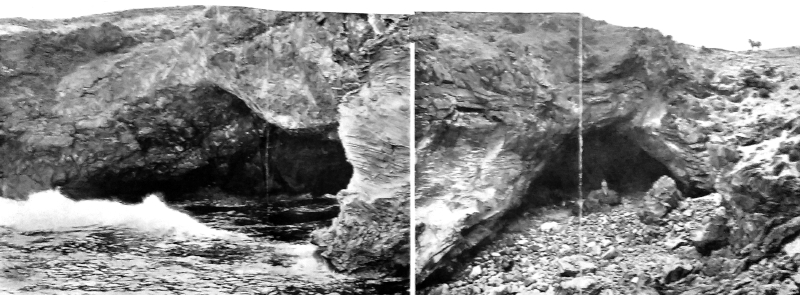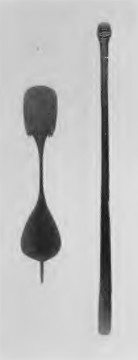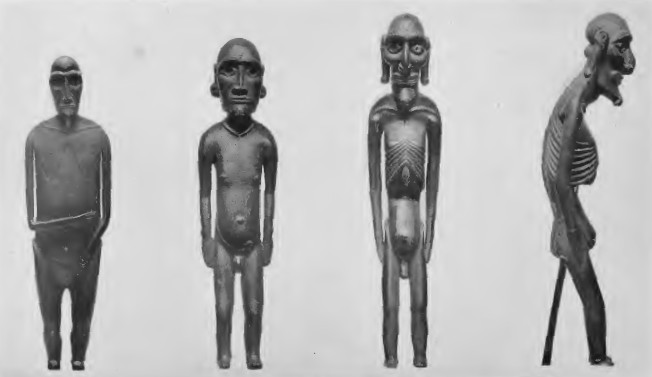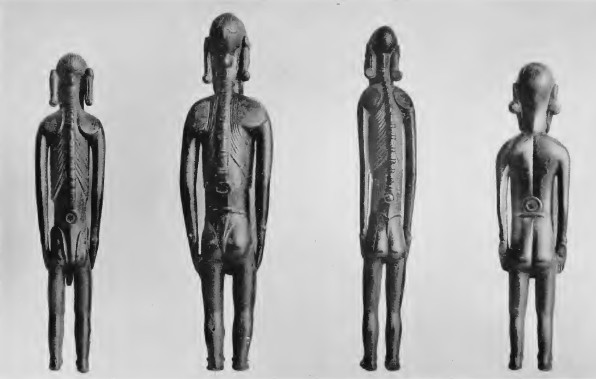| Web
and Book design,
Copyright, Kellscraft Studio 1999-2015 (Return to Web Text-ures) |
 (HOME)
|
| CHAPTER
XVI NATIVE CULTURE IN PRE-CHRISTIAN TIMES (continued) Religion — Position of the Miru Clan — The Script — The Bird Cult — Wooden Carvings. RELIGION The
religion of the Islanders, employing the word in our sense, seems
always to
have been somewhat hazy,1 and the difficulty in grasping it
now is
increased by the fact that since becoming Roman Catholics they dislike
giving
the name of "atua," or god, to their old deities; it only drops out
occasionally. They term them "aku-aku," which means spirits, or more
frequently "tatane," a word of which the derivation is obvious. The
confusion of ideas was crystallised by a native, who gravely remarked
that they
were uncertain whether one of these beings was God or the Devil, so
they "wrote
to Tahiti, and Tahiti wrote to Rome, and Rome said he was not the
Devil, he was
God"; a modern view being apparently taken at headquarters of the
evolution of religious ideas. Both these words, tatane and aku-aku,
will be employed
for supernatural beings, without prejudice to their original character,
or
claims to divinity; some of them were certainly the spirits of the
dead, but
had probably become deified; the ancestors of Hotu-matua were reported
to have
come with him to the island. They existed in large numbers, being both
male and
female, and were connected with different parts of the island; a list
of about
ninety was given, with their places of residence. No worship was paid,
and the
only notice taken of these supernatural persons was to mention before
meals the
names of those to whom a man owed special duty, and invite them to
partake; it
was etiquette to mention with your own the patron of any guest who was
present.
There was no sacrifice; the invitation to the supernatural power was
purely
formal, or restricted to the essence of the food only. Nevertheless,
the
aku-aku, in this at least being human, were amiable or the reverse
according to
whether or not they were well fed. If they were hungry, they ate women
and
children, and one was reported as having a proclivity for stealing
potatoes;
if, on the contrary, they were well-disposed to a man, they would do
work for
him, and he would wake in the morning to find his potato field dug,
which, as
our informant truly remarked, was "no like Kanaka." The
aku-aku appeared in human form, in which they were indistinguishable
from
ordinary persons. One known as Ukao-hoheru looked like a very beautiful
woman,
and was the wife of a young Tupahotu who had no idea she was really a
tatane.
She lived with him at Mahatua on the north coast, and bore him a child.
One
very wet day she was obliged to leave the house to take fresh fire to
the
cooking-place where it had gone out. When she returned, her husband was
angry
that she had no red paint on her face, and, not heeding her explanation
that
the rain had washed it off, took a stick to beat her. She ran away, and
he
followed, till at last she sat down on the edge of the eastern
headland, where
there is now an ahu known by her name. When by and by he came up, she
told him
to go back and look after the child, and fled away like a rushing
whirlwind
over the sea and was no more seen. Two other
female tatane are reported to have lived together in a cave on the
cliff-side
of Paréhé,2 whose names were Kava-ara and Kava-tua. They
heard all
men tell of the beauty of a certain Uré-a-hohove, a young man who lived
near
Hanga Roa; so they went down to see him, put him to sleep, and carried
him on
his mat up to their cave, where they left him. Before going away they
told an
old woman, also an aku-aku, that she was not to go and look into the
cave. This
she naturally proceeded to do, and, finding Uré, warned him to eat
nothing the
two tatane might give to him, supplying him herself with some chicken.
When therefore
his captors came back and offered him food, he only pretended to take
it, and
ate the chicken instead. They then went away again. The old woman came
back,
and said, “If cockroaches come, kill them; if flies come, kill them;
but if a
crab comes, do not kill it." Uré did as he was told, and killed the
cockroaches and flies, which were other tatane; but the crab he did not
kill,
it was the old woman. Meanwhile for many days the father of Uré wept
for him,
till some men sailing under the cliff while fishing, heard a song, and
looking
up saw the missing man; but they would not go and fetch him, though the
father
gave them much food, for the cliff was steep and the cave difficult to
reach.
At last a woman volunteered for the task, and was lowered over the
cliff in a
net, and by this means succeeded in fetching Uré safely to the top. The
history
ends with his return to his home, and does not mention if, in correct
fashion,
he married his fair deliverer. Aku-aku
were not immortal. A man called Raraku, after whom the mountain is said
to have
been named, caught a big "heke," which seems to have been an octopus,
in the sea near Tongariki and ate it, with the result that he went mad,
and all
people gave chase to him. He caught up a wooden lizard (fig. 117), and,
using
it as a club, ran amok among tatane across the north shore and down the
west
coast, killing them right and left; the names of twenty-three were
given who
thus met their fate. Human
beings, on the other hand, were liable to be attacked by tatane, more
particularly at night, when there was risk, not only to their bodies,
but also
to their own spirits,3 which were at large while they slept.
It is
still firmly believed that in dreams the soul visits any locality
present to
the thought. On one of the ahu is a rough erection of slabs, said to be
the
house of the aku-aku Mata-wara-wara, or "Strong-Rain." He had as a
partner another aku-aku called Papai-a-taki-vera, and they arranged
between
them that Mata should bring on rain, while Papai constructed a house of
reeds
which was only there at night; then when the spirits of sleeping
people, which
were wandering abroad, became cold with the rain, they went into the
house and
the tatane killed them. The unfortunate sleeper waked in the morning
feeling
distinctly unwell, he lingered on for two or three days, and then died.
It was
not essential to life to have a soul, but you could not really get on
comfortably without it. No knowledge survives of any belief or ideas
with
regard to a future state. The spirit, it was said, appeared
occasionally for
five or ten years after a man's death and then vanished. Pan in
the shape of tatane is by no means dead. Not only do such beings haunt
the
crater of Rano Raraku, but tales are told of weird apparitions at dusk
which
vanish mysteriously into space. There
were no priests, but certain men, known as "koromaké," practised
spells which would secure the death of an enemy, and there was also the
class
known as "ivi-atua," which included both men and women. The most
important of these ivi-atua, of whom it was said there might be perhaps
ten in
the island, held commune with the aku-aku, others were able to
prophesy, and
could foresee the whereabouts of fish or turtle, while some had the
gift of
seeing hidden things, and would demand contributions from a secreted
store of
bananas or potatoes, in a way which was very disconcerting to the
owner. There was
practically only one religious function of a general nature; it was
very
popular and had a surprising origin. Attention was attracted on the
south coast
by a particularly long stoep of rounded pebbles measuring 139 feet, and
obviously connected with a thatched house now disappeared. That, our
guides
said in answer to a question, “is a haré-a-té-atua, where they praised
the
gods." "What gods?” "The men who came from far away in ships.
They saw they had pink cheeks, and they said they were gods." The early
voyagers, for the cult went back at least three generations, were
therefore
taken for deities in the same way as Cook was at Hawaii. The simplest
form of
this celebration took place on long mounds of earth known as
"miro-o-orne,"
or earth-ships, of which there are several in the island, one of them
with a
small mound near it to represent a boat. Here the natives used to
gather
together and act the part of a European crew, one taking the lead and
giving
orders to the others. A more formal ceremony was held in a large house.
This
had three doors on each side by which the singers entered, who were up
to a
hundred in number, and ranged themselves in lines within; in one house,
of
which a diagram was drawn, a deep hole was dug in the middle, at the
bottom of
which was a gourd covered with a stone to act as a drum. On the top of
this a
man danced, being hidden out of sight in the hole. In other
cases, two, or perhaps three, boats were constructed inside the house,
the
masts of which went through the roof; these boats were manned with
crews clad
in the garments of European sailors, the gifts from passing vessels
being kept
as stage properties. Fresh music was composed for every occasion, and
in one
song, which was quoted, much reference is made to the "red face of the
captain from over the seas." The position of chief performer was one of
great honour, being analogous, on a glorified scale, to the leader of a
cotillon of our own day. It was stated by an old man that his
great-grandfather
had so acted, and even the words sung were still remembered. Te Haha, a
Miru
(fig. 83), gave us to understand that he had been a great social
success in his
youth, and counted up three koro, and seven hare-ate-atua at which he
had been
present. As he was a handsome old man, and was connected with the court
of the
chief Ngaara, his pride of recollection was very probably justified.
Juan,
mixing up, no doubt, recollections of a later date, gave a vivid
representation
on one of these spots of the pseudo-captain striding about and using
very
strong language, while he called upon the engineer to "make more smoke
so
that the ship should go fast." On the
border-line, between religion and magic, wherever, if anywhere, that
line
exists, was the position of the clan known as the Miru. Members of this
group
had, in the opinion of the islanders, the supernatural and valuable
gift of
being able to increase all food supplies, especially that of chickens,
and this
power was particularly in evidence after death. It has been known that
certain
skulls from Easter are marked with designs, such as the outline of a
fish;
these are crania of the Miru, and called "puoko-moa," or fowl-heads,
because they had, in particular, the quality of making hens lay eggs
(fig. 96).
Hotu, the Miru, whose mother, it may be remembered, was the victim of a
cannibal feast, made his own skull an heirloom, as "it was so extremely
good for chickens," that he did not wish it to go out of the family.
His
son gave it to a relative, who was the father of an old man from whom
we managed
to obtain it. When the time came to hand it over to us, the late owner
began to
cling to it affectionately, and say that he "wept much at the thought
of
its going to England"; as, however, the bargain had already been
completed, we remained obdurate, and at the time of writing Hotu
resides with
Ko Tori at the Royal College of Surgeons. The Miru
were unique in other ways; they were the only group which had a headman
or
chief, who was known as the "ariki," or sometimes as the
"ariki-mau," the great chief, to distinguish him from the
"ariki-paka," a term which seems to have been given to all other
members of the clan. The office of ariki-mau was hereditary, and he was
the
only man who was obliged to marry into his own clan.4 It was
customary when he was old and feeble that he should resign in favour of
his
son. There are various lists of the succession of chiefs, counted from
the
first immigrant, Hotu-matua . The oldest lists are those given by
Bishop
Jaussen5 and by Admiral Lapelin,6 which contain
some
thirty names. Thomson gives one with fifty-seven. In our day there was
admittedly much uncertainty about the sequence, but the number was said
to be
thirty,7 and two independent lists were obtained. All these
categories differ, though they contain many of the same names,
particularly at
the beginning and end. 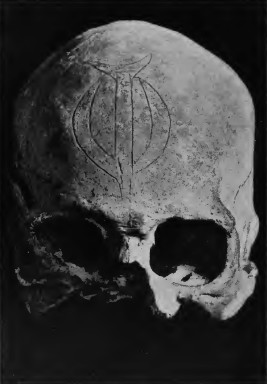 [Butterworth] FIG. 96. — A MIRU SKULL WITH INCISED DESIGN. The last
man to fill the post of ariki with its original dignity was Ngaara; he
died
shortly before the Peruvian raid, and becomes a very real personage to
anyone
inquiring into the history of the island. He was short, and very stout,
with
white skin, as had all his family, but so heavily tattooed as to look
black. He
wore feather hats of various descriptions, and was hung round both back
and
front with little wooden ornaments, which jingled as he walked. When
our
authorities can remember him his wife was dead and he lived with his
son
Kaimokoi. It was not permitted to see them eat, and no one but the
servants was
allowed to enter the house. His headquarters were at Anakena, the cove
on the
island where, according to tradition, the first canoe landed. It is
unique in
having a sandy shore, and is surrounded by an amphitheatre of low
hills. Behind
it to the west rises the high central ground of the island, beyond it,
on the
other side, is the eastern plain; it thus approximately terminates the
strip of
land held by the Miru (fig. 97). There are now at Anakena the remains
of six
ahu, a few statues, and the foundations of various houses. Ngaara held
official
position for the whole island, but he was neither a leader in war, nor
the
fount of justice, nor even a priest; he can best be described as the
custodian
of certain customs and traditions. The act most nearly approaching a
religious
ceremony was conducted under his auspices, though not by him
personally. In
time of drought he sent up a younger son and other ariki-paka to a
hill-top to
pray for rain: they were painted on one side red, on the other black
with a
stripe down the centre. These prayers were addressed to Hiro, said to
be the
god of the sky, a supernatural being in whom we seem getting nearer the
idea of
a divinity, as distinct from a spirit of the dead, and of whom we would
gladly
have learnt more than could be discovered. 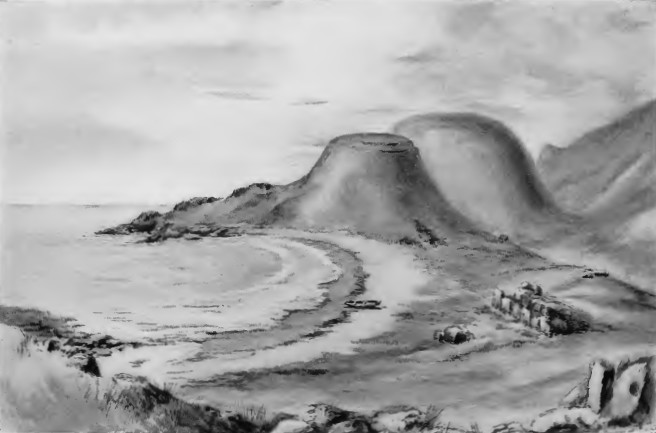 FIG. 97. — ANAKENA COVE. Hill on left terraced summit. The
ariki-paka had other duties besides praying for rain; they made "mam,"
or strings of white feathers tied on to sticks, which they placed among
the
yams to make them grow. They buried a certain small fish among the
sugar-canes
to bring up the plants, and when a koro was being held, and it was
consequently
particularly desirable that the fowls should thrive, an ariki-paka
painted a
design in red, known as the “rei-miro," below the door of the
chicken-house (fig. 115). Te Haha,
the "social success," who was an ariki-paka in the entourage of
Ngaara, gave graphic descriptions of life at Anakena when he was a boy.
If, he
said, people wanted chickens, they applied to the Ariki-mau, who sent
him with
maru, and his visits were always attended with satisfactory results. Ngaara
never consumed rats, and one day, coming across the boy watching rats
being
cooked, he was extremely angry, for it transpired that, if Te Haha ha(i
eaten
them, his power for producing chickens would have diminished;
presumably
because he would have imbibed ratty nature, which was disastrous to
eggs and
young chickens. The Ariki, however, made himself useful to him on
occasion. The
younger Miru had long hair reaching to his heels, and one day, when he
was
asleep in a cave, some one cut it off. So he went to Ngaara, who told
him to
bring ten coconuts, which he broke and put in pieces of the sacred
tree, “ngau-ngau";
the spell blasted the offender, who promptly died. Ngaara himself
attended the
inauguration of any house of importance. The wooden lizards were put
formally
on each side of the entrance to the porch, and the Ariki and an
ivi-atua, who
"went with him like a tatane," were the first to eat in the new
dwelling: only the houses with stone foundations were thus honoured.
The Ariki
was visited one month in the year by "all people," who brought him
the plant known as pua on the end of sticks, put the pua into his
house, and
retired backwards. He also
held receptions on other occasions, seated on the broken-off head of an
old
image, which was pointed out on a grassy declivity among the hills
behind
Anakena; these were special occasions for criticising the tattoo. Those
who
were well tattooed were sent to stand on one hill slope, whilst those
who were
badly done were sent to another; the Ariki and men behind him laughed
contemptuously at the latter, which, as the process was permanent and
could not
be altered, seems slightly unkind. These receptions were also attended
by men
who had made boats, and by twins, to whom the Ariki gave a "royal
name." Such children were not, as in so many countries, considered
unlucky,
but it was necessary that at birth they should live in a house apart,
otherwise
they would not survive. This superstition still exists. Shortly before
our
arrival a woman in the village had given birth to twins, for whom a
little
grass house was put up; another woman went in and brought them out to
the
mother to nurse. Closely
connected with the subject of the Miru clan is that of the method of
writing.
While we can only catch glimpses of the. image cult through the mists
of antiquity,
the tablets, known as "kohau-rongo-rongo,"8 were an
integral part of life on the island within the memory of men not much
past
middle age (fig. 98). The highest authority on them was the ariki
Ngaara. It
was tantalising to feel how near we were to their translation and yet
how far.
Te Haha had begun to learn to write, but found that his hand shook too
much,
besides, as he explained, Ngaara used "to send him to the chickens."
Juan had had the offer of learning one form of such script, but, not
unnaturally, had looked upon it with some contempt, preferring European
accomplishments. The information which could be gathered was,
therefore, with
one exception, which will be noted later, simply that of the layman, or
man in
the street, who had been aware of the existence of the art and seen it
going on
around him, but had no personal knowledge. The
tablets were of all sizes up to 6 feet. It was a picturesque sight to
see an old
man pick up a piece of banana-stem, larger than himself, from among the
grove
in which we were talking, and stagger along with it to show what it
meant to
carry a tablet, though, as he explained, the sides of the tablet were
flat, not
round like the stem. It is said that the original symbols were brought
to the
island by the first-comers, and that they were on "paper," that when
the paper was done, their ancestors made them from the banana plant,
and when
it was found that withered they resorted to wood. Every clan had
professors in
the art who were known as rongo-rongo men ("tangata-rongo-rongo").
They had houses apart, the sites of which are shown in various
localities. Here
they practised their calling, often sitting and working with their
pupils in
the shade of the bananas; their wives had separate establishments. In
writing,
the incision was made with a shark's tooth: the beginners worked on the
outer
sheaths of banana-stems, and later were promoted to use the wood known
as
"toro-miro."9 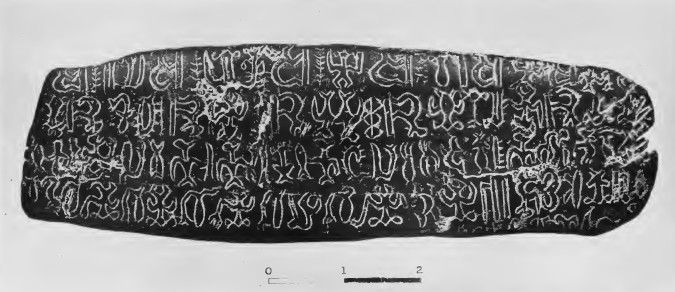 [Brit. Mus.] FIG. 98 — PORTION OF AN INCISED TABLET (Kohau-rongo-rongo) The
glyphs are, as will be seen, so arranged that when the figures of one
row are
right way up, those of the one immediately below it are on their heads;
thus
only alternate rows can, at the same time, be seen in correct position
(fig.
98). The method of reading was, according to Te Haha, to read one row
from left
to right, then come back reading the next from right to left, the
method known
as boustrophedon, from the manner in which an ox ploughs a furrow. The
finished
ones were wrapped in reeds and hung up in the houses. According to two
independent
authorities they could only be touched by the professors or their
servants, and
were taboo to the uninitiated, which, however, does not quite agree
with other
statements, nor with that of the missionaries that they were to be
found in
"every house." They were looked upon as prizes to be carried off in
war, but they were often burnt with the houses in tribal conflict. Ngaara is
said to have had "hundreds of kohau" in his house, and instructed in
the art, which he had learnt from his grandfather. He is described,
with a
vivid personal touch, as teaching the words, holding a tablet in one
hand and
swaying from side to side as he recited. Besides giving instruction, he
inspected the candidates prepared by other professors, who were
generally their
own sons; he looked at their kohau and made them read, on which he
either
passed them, clapping if they did well, or turned them back. Their
sponsors
were made personally responsible. If the pupils acquitted themselves
creditably, presents of kohau were made to the teachers; if the youth
failed,
the tablets of the instructor were taken away. Every
year there was a great gathering of rongo-rongo men at Anakena,
according to Te
Haha, as many as several hundreds of them came together. The younger
and more
energetic of the population assembled from all districts in the island
to look
on. They brought "heu-heu" (feathers on the top of sticks), tied pua
on to them, and stuck the sticks in the ground all round the place. The
inhabitants of the neighbouring districts brought offerings of food to
Ngaara,
that he should be able to supply the multitude, and the oven was "five
yards along." The gathering was near the principal ahu, midway between
the
sandy shore and the background of hills. The Ariki and his son Kaimokoi
sat on
seats made of tablets, and each had a tablet in his hand; they wore
feather
hats, as did all the professors. The rongo-rongo men were arranged in
rows,
with an alley-way down the centre to the Ariki. Some of them had
brought with
them one tablet only; others as many as four. The old ones read in
turn, or
sometimes two together, from the places where they stood, but their
tablets
were not inspected. Te Haha and his comrades stood on the outskirts,
and he and
one other lad held maru in their hands. If a young man failed, he was
called up
and his errors pointed out; but if an old man did not read well, Ngaara
would
beckon to Te Haha, who would go up to the man and take him out by the
ear. Our
informant repeated this part of the story identically months later, and
added
that the Ariki would say to the culprit, “Are you not ashamed to be
taken out
by a child?"; the offender's hat was taken away, but the tablet was not
inspected. The
entire morning was spent in hearing one half of the men read; there was
an
interval at midday for a meal, after which the remainder recited, the
whole
performance lasting till evening. Fights occasionally ensued from
people scoffing
at those who failed. Ngaara would then call Te Haha's attention to it,
and the
boy would go up to the offenders with the maru in his hand and look at
them,
when they would stop and there would be no more noise. "When the
function
was over, the Ariki stood on a platform borne by eight men and
addressed the
rongo-rongo men on their duties, and doing well, and gave them each a
chicken.
Another old man, Jotefa, gave a different account of the great
assembly, by
which the Ariki sat on his stoep and the old men stood before him and
"prayed"; according to this version they either did not bring their
tablets or their doing so was voluntary. In addition to the great day,
there
were minor assemblies at new moon, or the last quarter of the moon,
when the
rongo-rongo men came to Anakena. The Ariki walked up and down reading
the
tablets, while the old men stood in a body and looked on. Ngaara
used also to travel round the island, staying for a week or two in
different
localities with the resident experts. Another savant on the south coast
was
said to be "too big a man to have a school," and also went about
visiting and inspecting learned establishments in the same manner. Ngaara,
before the end, fell on evil days. The Ngaure clan was in the
ascendancy, and
carried off the Miru as slaves; the Ariki was taken to Akahanga on the
south
coast with his son, Kaimokoi, and grandson, Maurata. They were there
five years
in captivity, and the "Miru cried much"; at the end of that time the
clan united with the Tupahotu and rescued the old man. He was then ill,
and
died not long afterwards at Tahai, on the west coast, near Hanga Roa,
while
living with his daughter, who had married a Marama. For six days after
his
death everyone worked at making the sticks with feathers on the top
(heu-heu),
and they were put all round the place. He was buried in the ruined
image ahu at
Tahai, his body being carried on three of the tablets, and followed
through a
lane of spectators by the rongo-rongo men; the tablets were buried with
him.
His head paid the penalty of its greatness, and was subsequently
stolen; its
whereabouts was unknown. Ten or fifteen of his tablets were given to
old men;
the rest went to a servant, Pito, and on his death to Maura ta. When
Maurata
went to Peru, Také, a relative of Te Haha, obtained them, and Salmon
asked Te
Haha to get hold of them for him. Také, however, unfortunately owed Te
Haha a
grudge, because when Te Haha was in Salmon's service, and consequently
well
off, he did not give him as many presents as his relative thought
should have
been forthcoming, and he consequently refused to surrender them. They
were
hidden in a cave whose general locality was surmised, but Také died
without
making known the exact site, and they could never be found. Kaimokoi's
tablets
were burnt in war. The
question remains what were the subjects with which the tablets dealt,
and in
what manner did they record them? Various attempts have been made to
deal with
a problem which will probably never be wholly solved. Twice before our
own day
native assistance has been sought to decipher them. It will be
remembered that
the existence of these glyphs was first reported by the missionaries;
but even
at that time, when volunteers were asked for who could translate them,
none
came forward. Bishop Jaussen, Vicaire Apostolique of Tahiti, managed to
find in
that island a native of Easter among those brought there to work on the
Brander
plantations, who was supposed to understand them, and who read them
after the
boustrophedon method. From the information given by him, the Bishop was
satisfied that the signs represented different things, such as sun,
stars, the
ariki, and so forth, and has given a list of the figures and their
equivalent.
At the same time he held that each one was only a peg on which to hang
much
longer matter which was committed to memory. The other attempt to
obtain a
translation was that of Paymaster Thomson, of U.S.S. Mohican,
in 1886. There was then living an old man, Ure-vae-iko by
name, who was said to be the last to understand the form of writing; he
declined to assist in deciphering them on the ground that his religious
teachers had said it would imperil his soul. Photographs, however, were
shown,
and, by the aid of stimulants, he was induced to give a version of
their
meaning, the words of which were taken down by Salmon. It was, however,
remarked that when the photographs were changed, the words proceeded
just the
same. Inquiries
were made by the Expedition about this old man, and it was agreed by
the
islanders that he had never possessed any tablets nor could he make
them, but
that he had been a servant of Ngaara and had learnt to repeat them.
Before
leaving the island we went with the old men through the five
translations given
by Thomson. Of three nothing was known; one which describes the process
of
creation was recognised as that of a kohau, but looked at a little
askance, as
there were Tahitian words in it. The last was laughed out of court as
being
merely a love-song which everyone knew. Our own
early experiences had resembled those of the Americans. Photographs of
tablets,
which were produced merely to elicit general information, were to our
surprise
promptly read, certain words being assigned to each figure; but after a
great
deal of trouble had been taken, in drawing the signs and writing down
the
particular matter, it was found that any figure did equally well. The
natives
were like children pretending to read and only reciting. It was noted,
however,
with interest, that in perhaps half a dozen cases different persons
recited
words approximately the same, beginning, “He timo te ako-ako, he
ako-ako
tena," and on inquiry it was said that they were derived from one of
the
earliest tablets and were generally known. It was "like the alphabet
learned first"; Uré-vai-iko had stated that they were the "great old
words," all others being only "little ones." To get any sort of
translation was a difficult matter, to ask for it was much the same as
for a
stranger solemnly to inquire the meaning of some of our own old nursery
rhymes,
such as "Hey diddle diddle, the cat and the fiddle" — some words
could be explained, others could not, the whole meaning was unknown. It
seems
safe, however, to assume that at least we have here the contents of one
of the
old tablets. With
regard to other kohau, a list was obtained of the subjects with which
they were
believed to deal. These amounted to thirteen in all, most of the names
being
given by several different persons. We have seen that there was a kohau
of the
"Ika," the murdered men; this was known to only one professor, who
taught it to a pupil, and the two divided the island between them, the
master
taking the west and north coast to Anakena and the pupil the remainder.
A
connected, or possibly the same, tablet was made at the instance of the
relatives of the victim and helped to secure vengeance. Certain kohau
were said
to be lists of wars: some dealt with ceremonies, and others formed part
of
ceremonies themselves. They were in evidence at koro, where Ngaara and
the
professors used to come and "pray for the father," and a woman went
on to the roof of the house holding the "Kohau-o-te-pure" (prayer
tablet). In another case, a woman who wished to honour her
father-in-law, and
at the same time secure fertility, set up a pole round which she walked
holding
a child and a tablet, given her by Ngaara, while he and other
rongo-rongo men
who brought their kohau at his order stood by and sang. Perhaps
the most interesting tablet was one known as the "Kohauo-te-ranga."
The story was told to us sitting on the foundation of a house on the
east side
of Raraku, the aspect which is not quarried. This house, it was said,
had been
the abode of two men, who were old when the informant was a boy, and
who taught
the rongo-rongo; some days ten students would come, other days fifteen.
The
wives and children of the old men lived in another house lower down the
mountain. One of the experts, Arohio by name, was a Tupahotu, and had
as a
friend another member of the same clan called Kaara. Kaara was servant
to the
Ariki, and had been taught rongo-rongo by him, and Ngaara, trusting him
entirely, gave into his care this most valuable kohau known as "ranga."
It was the only one of the kind in existence, and was reported to have
been
brought by the first immigrants; it had the notable property of
securing
victory to its holders, in such a manner that they were able to get
hold of the
enemy for the "ranga" — that is, as captives or slaves for manual
labour. Kaara, anxious to obtain the talisman for his own clan, stole
the kohau
and gave it to Arohio, who kept it in this house. When Ngaara asked for
it, the
man said that it was at Raraku, but before the Ariki could get hold of
it,
Arohio sent it back to Kaara, and these two thus sent it backwards and
forwards
to one another, lying to Ngaara when needful. The Ariki seems to have
taken a
somewhat feeble line, and, instead of punishing his servant, merely
tried to
bribe him, with the result that he never again saw his kohau. The son
of Arohio
sold it to one of the missionaries, and it is presumably one of those
which
went to Tahiti. The matters with which it would naturally have been
supposed
that the rongo-rongo would deal, such as genealogies, lists of ariki,
or the
wanderings of the people, were never mentioned. We were
fortunately just in time to come across a man who had been able to make
one
species of glyphs, though he was no longer, alas! in the hey-day of his
powers.
We were shown one day in the village a piece of paper taken from a
Chilean
manuscript book, on which were somewhat roughly drawn a number of
signs, some
of them similar to those already known, others different from any we
had seen
(fig. 99). They were found to have been derived from an old man known
as
Tomenika. He was, by report, the last man acquainted with an inferior
kind of
rongo-rongo known as the "tau," but was now ill and confined to the
leper colony. We paid a visit to him armed with a copy of the signs,
but found
him inside his doorway, which it was obviously undesirable to enter,
and
disinclined to give help; he acknowledged the figures as his work,
recited
"He timo te ako-ako," and explained some of the signs as having to do
with "Jesus Christ." The outlook was not promising. Another
visit, however, was paid, this time with Juan's assistance, and though
the old
man appeared childish, and the natives frankly said that "he had lost
his
memory," things went better. He was
seated on a blanket outside his grass-hut, bare-legged, wearing a long
coat and
felt hat; he had piercing brown eyes, and in younger days must have
been both
good-looking and intelligent. He asked if we wanted the tau, and
requested a
paper and pencil. The former he put on the ground in front of him
between his
legs, and took hold of the pencil with his thumb above and first finger
below;
he made three vertical lines, first of noughts then of ticks, gave a
name to
each line, and proceeded to recite. There was no doubt about the
genuineness of
the recitation, but he gabbled fast, and when asked to go slowly so
that it
could be taken down, was put out and had to begin again; he obviously
used the
marks simply to keep count of the different phrases. At the end of the
visit he
offered to write something for next time. We left some paper with him,
and on
our return two or three days later he had drawn five lines
horizontally, of
which four were in the form of the glyphs, but the same figure was
constantly
repeated, and there were not more than a dozen different symbols in
all. It was
said by the escort to be "lazy writing." Tomenika complained that the
paper was not "big enough," so another sheet was given, which was put
by the side of the first and the lines continued in turn horizontally.
He drew
from left to right rapidly and easily. Unfortunately, it did not seem
wise to
touch the paper, but the writing was copied, by looking over it as he
went on,
with the sincere hope that his blanket did not contain too many
inhabitants of
some infectious variety. The recitation was partly the same as on the
previous
occasion, the signs taking the place of ticks; anything from three or
four to
ten words were said to each sign. If he made a variation when asked to
repeat,
it was in transposing the order of two phrases; evidently the signs
themselves
were not to him, now at any rate, connected with particular words. When we
subsequently went with our escort into the meaning of the words, it was
found
that the latter half of each phrase generally consisted of one of the
lower numericals
preceded by the word “tau," or year — thus, “the year four," "the
year five," etc.; the numbers, roughly speaking, ran in order of
sequence
up to ten, recommencing with each line. The first part of the phrase
was
generally said to be the name of a man, but of this it was difficult to
judge,
as children were called after any object or place; thus "flowering
grass" might be the name of a thing, or of a place, or of a man called
after either the object or the locality. Happily,
one of the most reliable old men, Kapiera by name, had at one time
lived with
Tomenika, who was said to have been in those days always busy writing;
and he
was able to explain the general bearing of the tau. When a koro was
made in
honour of a father, an expert was called in to commemorate the old
man's deeds,
“how many men he had killed, how many chickens he had stolen," and a
tablet was made accordingly. There was, in addition, a larger tablet
containing
a list of these lesser ones, and giving merely the name of each hero
and the
year of his koro. It would read somewhat thus, “James the year four,
Charles
the year five," and so forth, going up to the year ten, when the
numbers
began again. If there were two koro in a year, they came under the same
numeral. It was this general summary which had been recited by
Tomenika, and,
though there was a certain amount of confusion, each line seems to have
represented a decade. In addition, as will be seen, “James" and
"Charles
" each had a kohau of their own. Kapiera
was able to give a specimen of the lesser tau; it illustrates
interestingly the
general method of condensation in which, even in the recitations, a few
words
assume or implicate extended knowledge. It ran thus, “Of Kao the year
nine," "Ngakurariha the eldest"; then come five men's names
followed by the name of a fish; then a doubtful word; then "that side
island my place." "I see Ngakurariha at the koro." The story, as
explained, was that Kao, a man of Vinapu on the south coast, and
Ngakurariha,
his eldest son, went to Mahatua on the north side and stayed with the
five men
whose names are given, who were brothers, and learnt from them the tau.
Having
done this, they proceeded to murder them, and went and took a fish,
then returned
to Rano Kao, made a koro and the tau. The tau
was, it was said, originally made by an ancestor of the first immigrant
chief,
Hotu-matua; it was not taboo in the same way as the other rongo-rongo,
and was
not known to Ngaara. There were, about the beginning of last century,
only
three personages acquainted with it. One was Omatohi, a Tupahotu, whose
son,
Tea-a-tea, was Tomenika's foster-father and instructor in the art. It
was said
by Tomenika himself and by others that he "only knew part," and there
were other signs with which he was not acquainted, for his
foster-father had
died before he knew all. A great
effort was subsequently made to get further information from Tomenika,
more
particularly as to the exact method of writing, but he was back in his
hut very
ill, and all conversation had once more to be done through the doorway.
Every
way that could be thought of was tried to elicit information, but
without real
success. He did draw two fresh symbols, saying first they were "new"
and then "old," and stating they represented the man who gave the
koro, but "there was no sign meaning a man." "He did not know
that for ariki, the old men did," "the words were new, but the
letters were old," "each line represented a koro." An attempt to
get him to reproduce any tau made by himself was a failure. The
answers, on the
whole, were so wandering and contradictory, that after a second visit
under
those conditions, making five in all, the prospect of getting anything
further
of material value did not seem sufficient to justify the risks
toothers,
however slight. As the last interview drew to a close, I left the hut
for a
moment, and leant against the wall outside, racking my brains to see if
there
was any question left unasked, any possible way of getting at the
information;
but most of what the old man knew he had forgotten, and what he dimly
remembered he was incapable of explaining. I made one more futile
effort, then
bade him good-bye and turned away. It was late afternoon on a day of
unusual
calm, everything in the lonely spot was perfectly still, the sea lay
below like
a sheet of glass, the sun as a globe of fire was nearing the horizon,
while
close at hand lay the old man gradually sinking, and carrying in his
tired
brain the last remnants of a once-prized knowledge. In a fortnight he
was dead. 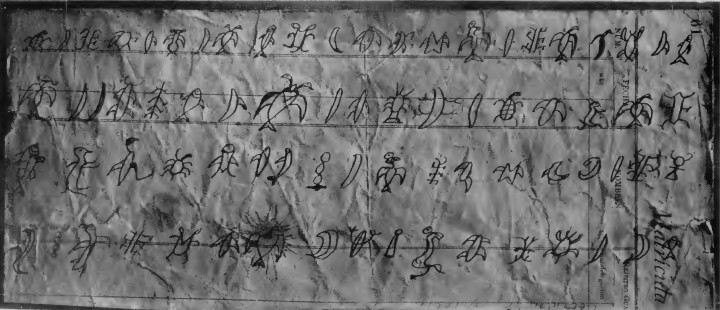 FIG. 99. — TOMENIKA’S SCRIPT. No
detailed systematic study of the tablets has as yet been possible from
the
point of view of the Expedition, but it seems at present probable that
the
system was one of memory, and that the signs were simply aids to
recollection,
or for keeping count like the beads of a rosary. To what extent the
figures
were used at will, or how far each was associated with a definite idea
it is
impossible to say. Possibly there was no unvarying method; certain ones
may
conveniently have been kept for an ever-recurrent factor, as the host
in the
tau, and in well-known documents, such as "he timo te ako-ako," they
would doubtless be reproduced in orthodox succession. But in the
tablets which
we possess the same figures are continually repeated, and the fact that
equivalents were always having to be found for new names, as in that of
the
fish-man, or ika, suggest that they may have been largely selected by
the
expert haphazard from a known number. As Tomenika said, “the words were
new,
but the letters were old," or to quote Kapiera to the same effect, they
were "the same picture, but other words." It will be noted how few
men are reported to have known each variety of rongo-rongo, and that
while
Ngaara looked at the tablets of the boys, apparently to see if they
were
properly cut, it was in the recitation only of the older men that
accuracy was
insisted on. The names which Bishop Jaussen's informant assigned to
some five
hundred figures may or may not be accurate, but whether the native or
anyone
else could have stated what the signs conveyed is another matter. It is
easy to
give the term for a knot in a pocket-handkerchief, but no one save the
owner
can say whether he wishes to remember to pay his life insurance or the
date of
a tea-party. In trying
to enter into the state of society and of mind which evolved the
tablets there
are two points worth noticing. Firstly, the Islanders are distinctly
clever
with their hands and fond of representing forms. Setting aside the
large
images, the carving of the small wooden ones is very good, and the
accuracy of
the tablet designs is wonderful. Then they have real enjoyment in
reciting
categories of words; for example, in recounting folktales, opportunity
was
always gleefully taken of any mention of feasting to go through the
whole of
the food products of the island. In the same way, if a hero went from
one
locality to another, the name of every place en route
would be rolled out without any further object than the
mere pleasure of giving a string of names. This form of recitation
appears to
affect them aesthetically, and the mere continuation of sound to be a
pleasure.
Given, therefore, that it was desired to remember lists of words,
whether
categories of names or correct forms of prayer, the repetition would be
a
labour of love, and to draw figures as aids to recollection would be
very
natural. Nevertheless,
the signs themselves have no doubt a history, which as such, even apart
from
interpretation, may prove to be signposts in our search for the origin
of this
mysterious people. Knowledge of the tablets was confined to a few, and formed a comparatively small element of life in the island; the whole of social existence revolved round the bird cult, and it was the last of the old order to pass away. The main object of the cult was to obtain the first egg of a certain migratory sea-bird, and the rites were connected with the western headland, Rano Kao. Little has yet been said of this volcano, but, from the scenic point of view, it is the most striking portion of the island. Its height is 1,300 feet, and it possesses a crater two-thirds of a mile across, at the bottom of which is a lake largely covered with weeds and plant-life. On the eastward, or landward face, the mountain, as already explained, slopes downward with a smooth and grassy incline, and the other three sides have been worn by the waves into cliffs over 1,000 feet in height. On the outermost side the sea has nearly forced its way into the crater itself; and the ocean is now divided from the lake at this point by only a narrow edge, along which it would be possible but not easy to walk with safety. At some near date, as geological ages reckon, the island will have a magnificent harbour (figs. loo and io8) . Off this part of the coast are three little islets, outlying portions of the original mountain, which have as yet withstood the unceasing blows of the ocean. Their names are Motu Nui, Motu Iti, and Motu Kao-kao, and on them nest the sea-birds which have for unknown centuries played so important a part in the history of the island. On the mainland, immediately opposite these islets, there is on the top of the cliff a deserted stone village; it is known as Orongo, and in it the Islanders awaited the coming of the birds. It consists of nearly fifty dwellings arranged in two rows, both facing the sea, and partly overlapping; the lower row terminates just before the narrowest part of the crater wall is reached. The final houses are built among an outcrop of rocks; they are betwixt two groups of stones, and have in front of them a small natural pavement. The stones nearest the cliff look as if at any moment they might join their brethren in headlong descent to the shore below (fig. 103) . Both the upstanding rocks and pavement are covered with carvings; some of them are partly obliterated by time, and can only be seen in a good light, but the ever-recurrent theme is a figure with the body of a man and the head of a bird; portions of the carvings are covered by the houses, and they therefore antedate them. 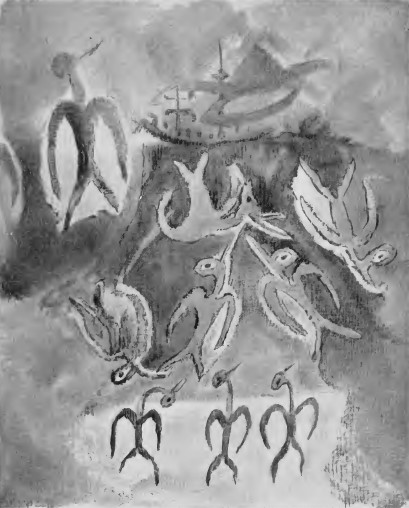 FIG. 102. — PAINTINGS ON ROOF OF ANA KAI-TANGATA. Top, a bird superimposed on a European ship. The whole
position is marvellous, surpassing the wildest scenes depicted in
romance.
Immediately at hand are these strange relics of a mysterious past; on
one side
far beneath is the dark crater lake; on the other, a thousand feet
below,
swells and breaks the Pacific Ocean, it girdles the islets with a white
belt of
foam, and extends, in blue unbroken sweep, till it meets the ice-fields
of the
Antarctic. The all-pervading stillness of the island culminates here in
a
silence which may be felt, broken only by the cry of the sea-birds as
they
circle round their lonely habitations. 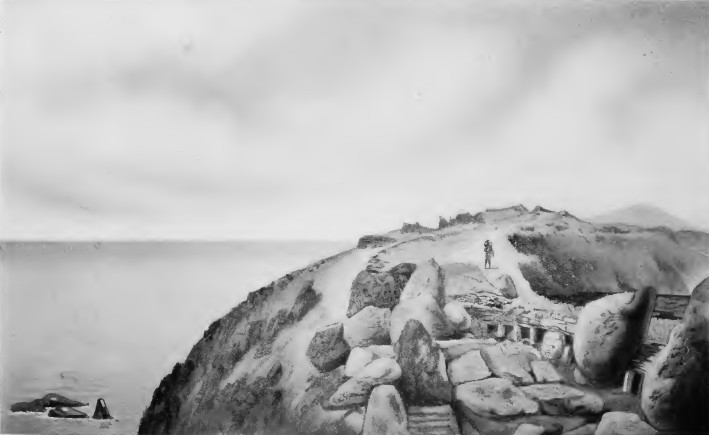 FIG. 103. — ORONGO, END HOUSES AND CARVED ROCKS. The stone
village formed the scene of some of our earliest work during our first
residence at the manager's house; for some weeks, weather permitting,
we rode
daily up the mountain, an ascent which took about fifty minutes, and
spent the day
on the top studying the remains, and picking the brains of our native
companions. Some of the houses have been destroyed in order to obtain
the
painted slabs within, but most are in fair, and some in perfect,
preservation.
The form of construction suitable to the low ground has perhaps been
tried here
and abandoned, for some of the foundation-stones, pierced with the
holes to
support the superstructure of stick and grass, are built into the
existing
dwellings. The present buildings (fig. 104) are well adapted to such a
wind-swept spot; they are made of stone laminć, with walls about 6 feet
thick;
the inside walls are generally lined with vertical slabs, and
horizontal slabs
form the roof. The greater number are built at the back into rising
ground, and
their sides and top are covered with earth; the natives call them not
"hare," or houses, but "ana," or caves. Where space permits
it, the form is boat-shaped, but some have been adapted to natural
contours.10 The
dwellings vary in shape and size, from 52 feet by 6 feet to 8 feet by 4
feet;
the height within varies from 4 feet to over 6 feet, but it is the
exception to
be able to stand upright. In some cases they open out of one another,
and not
unfrequently there is a hatch between two through which food could be
passed.
The doorway, with its six foot of passage, is just large enough to
admit a man.
Into each of them, armed with ends of candles, we either crawled on
hands and
knees, or wriggled like serpents, according to our respective heights.
The
slabs lining the wall, which are just opposite the doorway, and thus
obtain a
little light, are frequently painted; some of them have bird and others
native
designs, but perhaps the most popular is a European ship, sometimes in
full
sail, and once with a sailor aloft in a red shirt (fig. 105). Inside
the houses
we found the fiat, sea-worn boulders which are used as pillows and
often
incised with rough designs; there were also a few obsidian spear heads,
or
mataa, and once or twice sphagnum from the crater, which was used for
caulking
boats, and also as a sponge to retain fresh water when at sea. Outside
many of
the doors are small stone-lined holes, which we cleared out and
examined. They
measure roughly rather under 2 feet across by some 15 inches in depth.
Our guides
first told us that they were "ovens," but, as no ash was found, it
seems probable that their second thoughts were right, and they were
used to contain
stores. The groups of dwellings have various names, and are associated with the particular clans, who, it is said, built them. One house, which stands near the centre of the village, Taurarenga by name, is particularly interesting as having been the dwelling of the statue Hoa-haka-nanaia, roughly to be translated as "Breaking wave," now resident under the portico of the British Museum (fig. 31). Lying about near by were two large stones, which had originally served as foundations for the thatched type of dwelling, but had apparently been converted into doorposts for the house of the image; on one of them a face had been roughly carved (fig. 107). The statue is not of Raraku stone, and it will be realised how entirely exceptional it is to find a statue under cover and in such a position. The back and face were painted white, with the "tracings" in red. The bottom contracts, and was embedded in the earth, though a stone suspiciously like a pedestal is built into a near wall. The house had to be broken down in order to get the figure out. According to the account of the missionaries, three hundred sailors and two hundred Kanakas were required to convey it down the mountain to H.M.S. Topaze in Cook's Bay. The memory of the incident is fast fading, but our friend Viriamo repeated in a quavering treble the song of the sailors as they hauled down their load.11 The figure is some eight feet high and weighs about four tons. 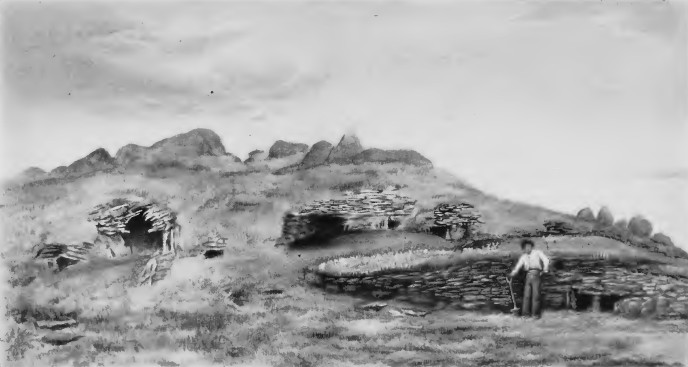 FIG. 104. — CENTRAL PORTION OF ORONGO VILLAGE. Left, house which contained image; centre, three houses opening on small quadrangle; right, canoe-shaped house with double entrance. Day by
day, as we worked, we gazed down on the islets. The outermost, which,
as its
name Motu Nui signifies, is also the largest, is more particularly
connected
with the bird story, which we were gradually beginning to grasp, and at
last
the call to visit it could no longer be resisted (fig. 109). It was not
an easy
matter, for Mana was away; the boats
of the natives left a good deal to be desired in the way of
seaworthiness, and
it was only possible to make the attempt on a fine day. Finally, on
arrival at
the island, it required not a little agility to jump on to a ledge of
rocks at
the second the boat rose on the crest of the waves, before it again
sank on a
boiling and surging sea till the heads of the crew were many feet below
the
landing-place. We managed, however, between us to get there three times
in all.
Once, when I was there without S., there was an anxious moment on
re-embarking.
No one quite knew what happened. Some of the crew said that the gunwale
of the
boat, as she rose on a wave, caught under an overhanging shelf of rock,
others
were of the opinion that the sudden weight of the last man, who at that
moment
leapt into the boat, upset her balance; anyway, this tale was very
nearly never
written. Once landed on the island, the surface is comparatively level
and
presents no difficulties; it is about five acres in extent, the greater
part is
covered with grass, and in every niche and cranny of the rock are
seabirds'
nests. By a large bribe of tobacco one of the most active old men was
induced
to accompany us, and to point out the sites of interest. Later, we
followed up
the story at Raraku, and so little by little at many times, in divers
places,
and from various people was gathered the story of the bird cult which
follows. The
fortunate clan, or clans, for sometimes several combined, left nothing
to
chance; in fact, as soon as one year's egg had been found, the incoming
party
made sure of their right of way by taking up their abode at the foot of
Rano
Kao — namely, at Mataveri. Here there were a number of the large huts
with
stone foundations; in these they resided, with their wives and
families. One of
our old gentlemen friends first saw the light in a Mataveri dwelling,
when his
people were in residence, or, to use the proper phraseology, when his
clan were
"the Ao."13 This name "ao" is also given to a
large paddle, as much as 6 feet in length, used principally, if not
exclusively, in connection with bird rites and dancing at Mataveri. In
some
specimens a face is fully depicted on the handle; in others the
features have
degenerated to a raised line merely indicating the eyebrows and nose.
There are
pictures of it on slabs in the Orongo houses, in which the face is
adorned with
vertical stripes of red and white after the native manner, as described
by the
early voyagers (figs. 105 and 118). Not many
sea-birds frequent this part of the Pacific, but on Motu Nui some seven
species
find an abiding-place. Some stay for the whole year, some come for the
winter,
and yet others for the summer. Among the last is a kind known to the
natives as
manu-tara12; it arrives in September, the spring of the
southern
hemisphere. The great object of life in Easter was to be the first to
obtain
one of the newly laid eggs of this bird. It was too solemn a matter for
there
to be any general scramble. Only those who belonged to the clan in the
ascendancy for the time being could enter on the quest. Sometimes one
group
would 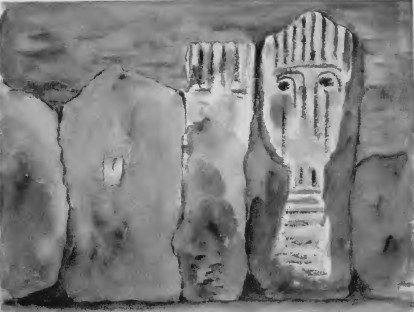 I. 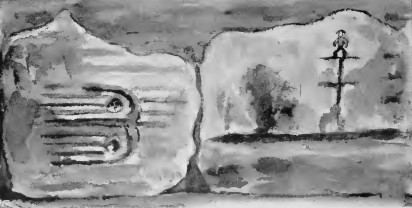 II. FIG. 105. — PAINTED SLABS FROM HOUSES AT ORONGO. I. Two pictorial representations of ao. II. A face adorned with paint. A European ship. [Height of slabs, 3 ft. to 3 ft. 6 in.] keep it
in their hands for years, or they might pass it on to a friendly clan.
This
selection gave rise, as might be expected, to burnings of hearts; the
matter
might be, and probably often was, settled by war. One year the Marama
were
inspired with jealousy because the Miru had chosen the Ngaure as their
successors, and burnt down the house of Ngaara. This was, perhaps, the
beginning of the fray when the old Ariki was carried off captive. 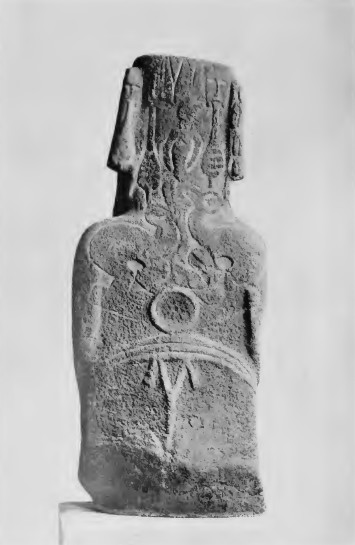 [W. A. M.& Co.] [Brit. Mus.] FIG. 106. — BACK OF STATUE FROM ORONGO. Showing raised ring and girdle, also incised figures of bird-man, ao, and Ko-Mari. (For front of statue, see fig. 31.) 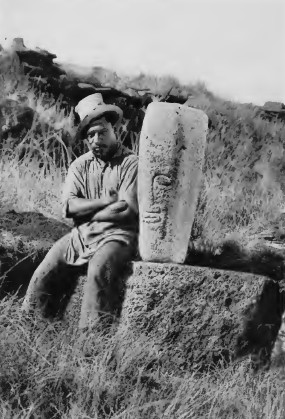 FIG. 107. — CARVED DOOR-POST, ORONGO. Naturally
the months passed at Mataveri were occupied by the residents in
feasting as
well as in dancing, and equally naturally the victims were human. It
was to
grace one of these gatherings, when the Ureohei were the Ao, that the
mother of
Hotu, the Miru, was slain in a way which he considered outraged the
decencies
of life, and it was in revenge for another Mataveri victim that the
last
statues were thrown down. It is told that the destined provender for
one meal evaded
that fate by hiding in the extreme end of a hut, which was so long and
dark
that she was never found. Some of these repasts took place in a cave in
the
sea-cliff near at hand. Here the ocean has made great caverns in a wall
of
lava, into which the waves surge and break with booming noise and
dashing
spray. The recess which formed the banqueting-hall is just above
high-water
mark, and is known as "Ana Kai-tangata," or Eat-man Cave (fig. 102).
The roof is adorned with pictures of birds in red and white; one of
these birds
is drawn over a sketch of a European ship, showing that they are not of
very
ancient date (fig. 103). When July
approached, the company, or some of them, wound their way up the
western side
of the hill, along the ever-narrowing summit to the village of Orongo;
the path
can just be traced in certain lights, and is known as the "Road of the
Ao." They spent their time while awaiting the birds in dancing each day
in
front of the houses; food was brought up by the women, of whom Viriamo
was one.
The group of houses at the end among the carved rocks was taboo during
the
festival, for they were inhabited by the rongo-rongo men, the western
half
being apportioned to the experts from Hotu Iti, the eastern to those
from
Kotuu. "They chanted all day; they stopped an hour to eat, that was
all." They came at the command of Ngaara, but it is noteworthy that he
himself .never appeared at Orongo, though he sometimes paid a friendly
call at
Mataveri. A short
way down the cliff immediately below Orongo is a cave known as
"Haka-rongo-manu," or "listening for the birds"; here men
kept watch day and night for news from the islet below. The
privilege of obtaining the first egg was a matter of competition
between
members of the Ao, but the right to be one of the competitors was
secured only
by supernatural means. An "ivi-atua," a divinely gifted individual,
of the kind who had the gift of prophecy, dreamed that a certain man
was
favoured by the gods, so that if he entered for the race he would be a
winner,
or, in technical parlance, become a bird-man, or "tangata-manu." The
victor, on being successful, was ordered to take a new name, which
formed part
of the revelation, and this bird-name was given to the year in which
victory
was achieved, thus forming an easily remembered system of chronology.
The
nomination might be taken up at once or not for many years; if not used
by the
original nominee, it might descend to his son or grandson. If a man did
not
win, he might try again, or say that "theivi-atua was a liar," and
retire from the contest. Women were never nominated, but the ivi-atua
might be
male or female, and, needless to say, was rewarded with presents of
food. There
were four "gods" connected with the eggs — Hawa-tuu-take-take, who
was "chief of the eggs," and Make-make, both of whom were males;
there were also two females. Vie Hoa, the wife of Hawa, and Vie
Kenatea. Each
of these four had a servant, whose names were given, and who were also
supernatural beings. Those going to take the eggs recited the names of
the gods
before meat, inviting them to partake. 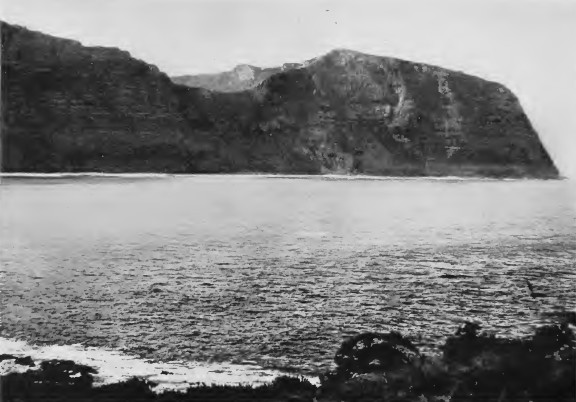 FIG. 108 — RANO KAO FROM MOTU NUI. 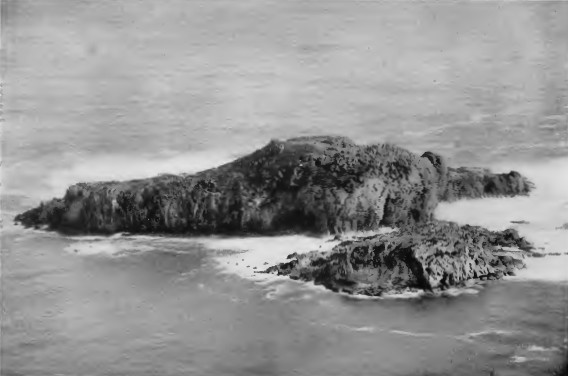 FIG. 109. — MOTU NUI AND MOTU ITI. The
actual competitors were men of importance, and spent their time with
the
remainder of the Ao in the stone houses of the village of Orongo; they
selected
servants to represent them and await the coming of the birds in less
comfortable quarters in the islet below. These men, who were known as
"hopu,"
went to the islet when the Ao went up to Orongo, or possibly rather
later. Each
made up his provisions into a "pora," or securely bound bundle of
reeds; he then swam on the top of the packet, holding it with one arm
and
propelling himself with the remaining arm and both legs. An
incantation, which
was recited to us, was said by him before starting. In one instance,
the
ivi-atua, at the same time that he gave the nomination, prophesied that
the
year that it was taken up a man should be eaten by a large fish. The
original
recipient never availed himself of it, but on his death-bed told his
son of the
prophecy. The son, Kilimuti, undeterred by it, entered for the race and
sent
two men to the islet; one of them started to swim there with his pora,
but was
never heard of again, and it was naturally said that the prophecy had
been
fulfilled. Kilimuti wasted no regret over the misfortune, obtained
another
servant, and secured the egg; he died while the Expedition was on the
island. The hopu
lived together in a large cave of which the entrance is nearly
concealed by
grass. The inside, however, is light and airy; it measures 19 feet by
13, with
a height of over 5 feet, and conspicuous among other carvings in the
centre of
the wall is a large ao more than 7 feet in length. A line dividing the
islet
between Kotuu and Hotu Iti passed through the centre of the cave, and
also
through another cave nearer the edge of the islet; in this latter there
was at
one time a statue about 2 feet high known as Titahanga-o-te-henua, or
The
Boundary of the Land.14 As bad weather might prevent fresh
consignments of food during the weeks of waiting, the men carefully
dried on
the rocks the skins of the bananas and potatoes which they had brought
with
them, to be consumed in case of necessity. It was added with a touch
appreciated by those acquainted with Easter Island, that, if the man
who thus
practised foresight was not careful, others who had no food would steal
it when
he was not looking. The
approach of the manu-tara can be heard for miles, for their cry is
their marked
peculiarity, and the noise during nesting is said to be deafening; one
incised
drawing of the bird shows it with open beak, from which a series of
lines
spreads out fanwise, obviously representing the volume of sound; names
in
imitation of these sounds were given to children, such as "Piruru,"
"Wero-wero," "Ka-ara-ara." It is worth noting that the
coming of the tara inaugurates the deep-sea fishing season; till their
arrival
all fish living in twenty or thirty fathoms were considered poisonous.
The
birds on first alighting tarried only a short time; immediately on
their
departure the hopu rushed out to find the egg, or, according to another
account, the rushing out of the hopu frightened away the birds. The
gods
intervened in the hunt, so that the man who was not destined to win
went past
the egg even when it lay right in his path. The first finder rushed up
to the
highest point of the islet, calling to his employer by his new name,
“Shave
your head, you have got the egg." The cry was taken up by the watchers
in
the cave on the mainland, and the fortunate victor, beside himself with
joy,
proceeded to shave his head and paint it red, while the losers showed
their
grief by cutting themselves with mataa. The
defeated hopu started at once to swim from the island to the shore,
while the
winner, who was obliged to fast while the egg was in his possession,
put it in
a little basket, and, going down to the landing-rock, dipped it into
the sea.
One meaning of the word hopu is "wash." He then tied the basket round
his forehead and was able to swim quickly, as the gods were with him.
At this
stage sometimes accidents occurred, for if the sea was rough, an
unlucky
swimmer might be dashed on the rocks and killed. In one instance, it
was said,
only one man escaped with his life, owing, as he reported, to his
having been
warned by Maké-maké not to make the attempt. When the hopu arrived on
the
mainland, he handed over the egg to his employer, and a
tangata-rongo-rongo
tied round the arm which had taken it a fragment of red tapa and also a
piece
of the tree known as "ngau-ngau," reciting meanwhile the appropriate
words. The finding was announced by a fire being lit on the landward
side of
the summit of Rano Kao on one of two sites, according to whether the Ao
came
from the west or east side of the island. It will be remembered that on the rocks which terminate the settlement of Orongo the most numerous of the carvings is the figure of a man with the head of a bird: it is in a crouching attitude with the hands held up, and is carved at every size and angle according to the surface of the rock (fig. 110). It can still be counted one hundred and eleven times, and many specimens must have disappeared: all knowledge of its meaning is lost. The figure may have represented one of the egg gods, but it seems more probable that each one was a memorial to a birdman; and this presumption is strengthened by the fact that in at least three of the carvings the hand is holding an egg (fig. 112). The history of another figure, a small design which is also very frequent, still survives and corroborates this by analogy; within living memory it was the custom for women of the island to come up here and be immortalised by having one of these small figures ("Ko Mari") cut on the rock by a professional expert. We know, therefore, that conventional forms were used as memorials of certain definite persons.15 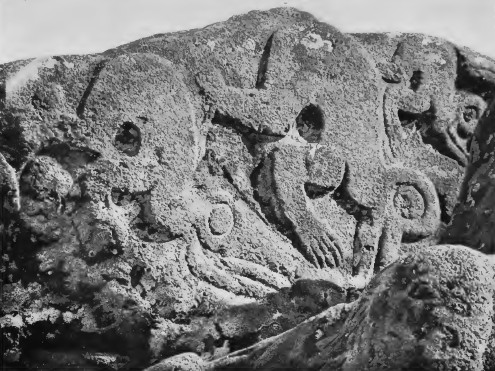 FIG. 110 — A ROCK AT ORONGO CARVED WITH FIGURES OF BIRD MEN. 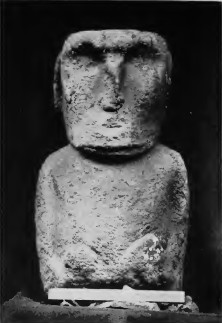 [Pitt Rivers Mus.] FIG. 111 — BOUNDARY STATUE FROM MOTU NUI [Measure shown = 1 ft.] 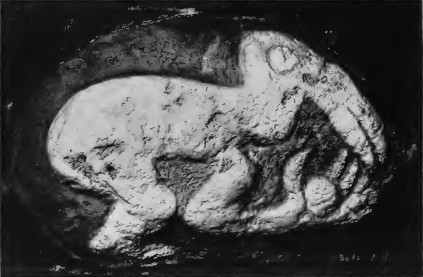 [Brit. Mus.] FIG. 112 — STONE EXHUMED AT ORONGO, 1914. Bird-man in low relief with egg in hand. length of carving, 36.5 cm. The
bird-man, having obtained the egg, took it in his hand palm upwards,
resting it
on a piece of tapa, and danced with a rejoicing company down the slope
of Rano
Kao and along the south coast, a procedure which is known as "haka
epa," or "make shelf," from the position of the hand with regard
to the egg. If, however, the winner belonged to the western clans, he
generally
went to Anakena for the next stage, very possibly because, as was
explained, he
was afraid to go to Hotu Iti; some victors also went to special houses
in their
own district, otherwise the company went along the southern shore till
they
reached Rano Raraku. Amongst
the statues standing on its exterior slope, there is shown at the
south-west
comer the foundations of a house (no. 7, fig. 60). This is the point
which
would first be approached from the southern coast, and here the
bird-man
remained for a year, five months of which were spent in strict taboo.
The egg,
which was still kept on tapa, was hung up inside the house and blown on
the
third day, a morsel of tapa being put inside. The
victor did not wash, and spent his time in "sleeping all day, only
coming
out to sit in the shade." His correct head-dress was a crown made of
human
hair; it was known as "hau oho," and if it was not worn the aku-aku
would be angry. The house was divided into two, the other half being
occupied
by a man who was called an ivi-atua, but was of an inferior type to the
one
gifted with prophecy, and apparently merely a poor relation of the
hero; there
were two cooking-places, as even he might not share that of the
bird-man. Food
was brought as gifts, especially the first sugar-cane, and these
offerings seem
to have been the sole practical advantage of victory; those who did not
contribute were apt to have their houses burnt. The birdman's wife came
to
Raraku, but dwelt apart, as for the first five months she could not
enter her
husband's house, nor he hers, on pain of death. A few yards below the
bird-man's house is the ahu alluded to on p. 191 (fig. 60); it consists
merely
of a low rough wall built into the mountain, the ground above it being
levelled
and paved. It was reserved for the burial of bird-men; they were the
uncanny
persons whose ghosts might do unpleasant things — they were safer
hidden under
stones. The name Orohie is given to the whole of this comer of the
mountain,
with its houses, its ahu, and its statues. To this point the figures
led which
were round the base of the hill. If they were re-erected, they would
stand with
their backs not to the mountain, but to Orohie.16 As the
bird-man
gazed lazily forth from the shade of his house, above him were the
quarries
with their unfinished work, below him were the bones of his dead
predecessors,
while on every hand giant images stood for ever in stolid calm. It is
difficult
to escape from the question. Were the statues on the mountain those of
bird-men? The ho pu
also retired into private life; if he were of the Ao, he could come to
Orohie,
but he might, if he wished, reside in his own house, which was in that
case
divided by a partition through which food was passed; it might not be
eaten
with his right hand, as that had taken the egg. His wife and children
were also
kept in seclusion and forbidden to associate with others. The new
Ao had meanwhile taken up their abode at Mataveri. From here a few
weeks after
their arrival they went formally to Motu Nui to obtain the young
manu-tara,
known from their cry as "piu." After the brief visit of the birds
when the first egg was laid, they absented themselves from the islet
for a
period varyingly reported as from three days to a month. On their
return they
laid plentifully, and, as soon as the nestlings were hatched, the men
of the celebrating
clan carried them to the mainland, swimming with them in baskets bound
round
the forehead after the manner of the first egg. They were then taken in
procession round the island, or, according to another account, only as
far as
Orohie. It was not until the piu had been obtained that it was
permissible to
eat the eggs, and they were then consumed by the subservient clans
only, not by
the Ao. The first two or three eggs, it was explained, were "given to
God";
to eat them would prove fatal. Some of the young manu tara were kept in
confinement till they were full grown, when a piece of red tapa was
tied round
the wing and leg, and they were told, “Kaho ki te hiva," "Go to the
world outside." There was no objection to eating the young birds. The
tara
departed from Motu Nui about March, but a few stragglers remained; we
saw one
bird and obtained eggs at the beginning of July, but the natives failed
to get
any for us in August. When in the following spring the new bird-man had
achieved his egg, he brought it to Orohie and was given the old one,
which he
buried in a gourd in a cranny of Rano Raraku; sometimes, however, it
was thrown
into the sea, or kept and buried with its original owner. The new man
then took
the place of his predecessor, who returned to ordinary life. The last
year that the Ao went to Orongo, which is known as "Rokunga," appears
to have been 1866 or 1867. The names of twelve subsequent years are
given,
during which the competition for the egg continued, and it was still
taken to
be interred at Raraku. The cult thus survived in a mutilated form the
conversion of the island to Christianity, which was completed in 1868;
it is
said that once the missionaries saw the Ao dancing with the egg outside
their
door in Hanga Roa and "told the people it was the Devil." It must
have been celebrated even after the assembly of the remains of the
clans into
one place, which occurred about the same time, but it was finally
crushed by
the secular exploiters of the island, whose house at Mataveri, that of
the present
manager, rests on the foundation-stones of the cannibal habitation
(fig. 25).
The cult admittedly degenerated in later years. A new practice arose of
having
more than one bird-man, with other innovations. The request to be given
the
names of as many bird-years as could be remembered met with an almost
embarrassing response, eighty-six being quoted straight away; some of
these may
be the official names of bird-men and not represent a year, but they
probably
do so in most cases; chronological sequence was achieved with fair
certainty
for eleven years prior to the final celebration at Orongo. In addition
to the
bird-name, the names of both winner and hopu were ascertained, with
those of
their respective clans. 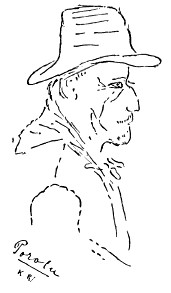 FIG. 113. TAKÉ AND
MANU Two other
ceremonies were mentioned in connection with Orongo and Motu Nui, but
to obtain
detailed information was very difficult. It finally transpired that of
"také" no firsthand knowledge existed, as the rites had been
abandoned thirty years before the coming of the missionaries. All that
can be
safely said is that those concerned went into retreat on Motu Nui,
living, it
was stated, in the cave where the hopu awaited the birds; the period
was
generally given as] three months. A vigorous discussion took place on
the
subject between Viriamo and Jotefa, the oldest man in the village,
seated on a
log in the garden of the old lady. She was positive, in agreement with
other
authorities, that take was for children — "the boys and girls went in a
canoe to the island"; he firmly adhered to the statement that his
father
went for take, after he, the son, was bom. Tomenika stated that také
formed the
subject of one of the tablets, and drew one of its figures, which bears
no
resemblance to any other known symbol. The
details of manu were more satisfactory. It was known as "te manu mo te
poki," or, “the bird for the child," and the child so initiated
became a "poki-manu," or "bird-child." It could not be
found that any special benefit resulted from it, but a child whose
parents had
not performed the ceremony, and whose love affairs, for instance, went
wrong,
might even kill his father in revenge for the omission. An expert,
known as
"tangata-tapa-manu," the man who, as Dr. Marett would tell us, “knew
the right things to say," was called in and given a hen's egg — on this
last point much stress was laid; he was at the same time told the
child's name,
which was subsequently inserted in the ritual. The child was shaved,
decorated
with white bands, and hung round with coconuts, or, as these were not
readily
obtainable in Easter Island, with pieces of wood carved to represent
them
called "tahonga." A number of children, each with an expert, then
went up to Orongo; the correct month was December, and the Ao were
therefore
below at Mataveri. Jotefa, on whose final account I principally rely,
stated
that he and nine other children, with their parents, and ten
tangata-tapamanu,
went to Orongo from his home on the north coast, a distance of some
eleven
miles; they took with them ten chickens. The party danced in front of
all the
houses, went to the carved rocks at the end, and, coming back, stood in
a
semicircle in front of the door of Taura-renga, the house of the
statue, the
experts being behind and all singing; no offering was made to the
image.
Another authority stated that the parents and children went on the roof
of the
house, the experts being below, and the parents gave chickens to the
men.
Jotefa 's party returned to their home, had a feast, and gave more food
to the
professionals. The tangata-tapa-manu subsequently repeated the ritual
at any
koro which were being held in the island, the object apparently being
to make
public the child's initiation. 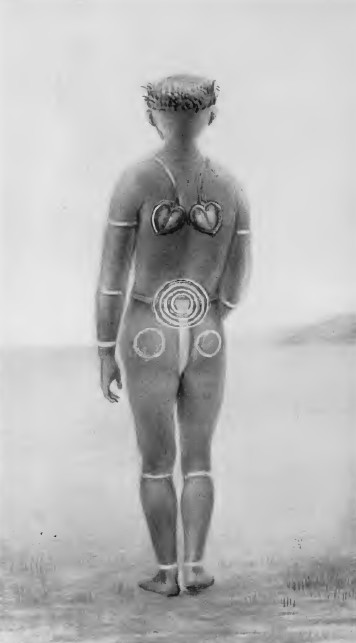 FIG. 114. — BIRD-CHILD (POKO-MANU). Ceremonial ornamentation, from a drawing made by natives. If, by
reason of the state of the island, it was not possible to go to Orongo,
the
ceremony could take place at any of the big ahu with images. Viriamo,
whose
home, as will be remembered,, was near Raraku, said with much pride
that she
was a "poki-manu"; she and her three younger sisters had been taken
at the same time to the ahu of Orohie. Both parents went, and the
mother took
two chickens, one in each hand, and the mother and children stood
upright and
the "maori sang"; they did not go to Orongo because there was war. A
drawing was made for us by Juan and the old men of the poki-manu in
ceremonial
attire (fig. 114); it was particularly interesting to find, when it was
handed
in, that circles of white pigment were made on the child's back, and
also on
each buttock, in a way which recalls the adornment of the Anakena image
(fig.
65). The stone
sculpture of Easter Island belongs to an era which is now forgotten;
there are
a number of wooden carvings which, whatever their original age, are
connected
with a recent past, and even in a limited sense with the present. The most
important of these works, the tablets, have already been dealt with,
and
mention has been made of the lizard figures, they have the head of that
animal
on a human body (fig. 117). The "ao," the large dancing-paddle, and
the smaller one, the "rapa," are of much the same character, though
used on different occasions (figs. 116 (a), 118). The "ua" is a club,
on the handle of which are two heads back to back; these clubs were
dignified
with individual names. The "paoa" was a wooden sword. There were also
bird ornaments carved in wood which were worn on the last day of the
koro and
by Ngaara. The "rei-miro" is a breast ornament of a crescent shape,
with a face at one or both ends; it is found depicted on the Orongo
rocks and
frequently on the tablets. It was especially a woman's decoration, but
a number
of small ones were said to have been worn by Ngaara. The specimen in
the
British Museum is embellished with glyphs, of which no account was
forthcoming
(fig. 115). Wooden
objects which are peculiarly interesting are the small male and female
figures
some twenty to thirty inches in height; the natives term them "moai,"
adding the word "miro," or wood (fig. 119). In a certain number of
these the ribs are very prominent, giving the effect of emaciation;
they are
called “moai kava-kava," or the statues with ribs. It has been
suggested
that this represents the condition in which the first inhabitants
reached the
island, but such an explanation is strenuously denied by the present
people,
who assert that their ancestors arrived with plenty of food. The
figures have
long ears, like the statues in stone, and a marked feature is their
little
goatee beards. These beards are found in three or four statues at
Raraku, in a head in relief on Motu Nui, and one
is indicated in fig. 31.
But the most striking link with the stone figures is the back, where
there is a
ring similar to that found on the larger statues: the girdle and M-like
design
below it also appear in varying degree (fig. 120). A comparative study
of the
backs of the wooden images has suggested the idea17 that
this M-like
marking in stone may be simply the last stage of an evolution in
design, which
originally showed the lines of the lower portion of the back and thigh.18
It would be satisfactory if, in the
same
way, the triple belt could be connected with the ribs and the ring with
the
vertebrae, but for this the evidence is less conclusive, although the
ribs of
the body with the lizard head closely approach the conventional. It
must be
remembered that the figures are nude, and that therefore these designs
can
scarcely represent any form of dress. There is a pronounced excrescence
on the
buttocks in the wooden figures, which is also a mystery, but which
recalls the way
in which the rings on the image found at Anakena (fig. 65) and those on
the
poki-manu (fig. 114) emphasise the same part of the anatomy. The heads
are
embellished with ornaments, some of which are bird designs (Fig. 121).
These
figures were worn by men only, and hung round the neck on important
occasions;
they were parts of the festival dress at Mataveri and at the koro. 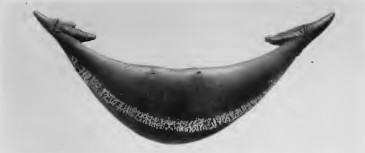 [Brit. Mus.] FIG. 115. — REI-MIRO, A BREAST ORNAMENT. 16 inch.
The
tradition of the origin of the wooden images is one of the best known
and
uniformly narrated, but obviously bears the marks of endeavouring to
explain
facts whose genesis has been forgotten. It runs thus: Tuukoihu, an
ariki, and
one of the first immigrants, was a clever man or "tangata-maori"; he
had two houses, one at Ahu Tepeu on the west side and one at Hanga
Hahave on
the south coast — the foundations of both are shown. One night, when he
was
sleeping at the latter dwelling, two female aku-aku appeared to him, by
name
Papa Ahiro and Papa Akirani.19 When he awoke he took the
wood called
toro-miro, and carved two figures with faces, arms, and legs, just as
he had
seen the aku-aku. When he had finished the work, he went over to Hanga
Roa to
fish. He slept there, and returned at daybreak, going back by the
quarry of the
stone hats. Two male aku-aku, by name Ko Hitirau and Ko Nuku-te-mangoa,
were
sleeping by the way, but were aroused on his approach by two more
aku-aku,
whose names are given, who told them that there was a man coming who
would
notice that their ribs were exceedingly "bad." The two sleepers
awoke, saw Tuukoihu, and asked him, “Have you seen anything?” He
discreetly
replied "nothing," and they disappeared. They again met him on the
road and put the same question, to which he gave the same answer. When
he got
to his house, he made two statues with ribs to represent the
apparitions. After
dark they prowled round the house, listening, with their hands up to
their
ears, to hear if he gossiped about what he had seen, intending if he
did so to
kill him. The Ariki, however, held his tongue. Later he went to his
other home;
there he took the wooden moai, both male and female, and made them
walk. The house
bears the lengthy name of "The House of the Walking Moai of Tuukoihu,
the
Ariki," and is the large one whose measurements were given on p. 216.
Tuukoihu once lent a moai-miro to a man, whose house took fire while it
was in
his possession. The Ariki, on hearing of the disaster, told the image
to fly
away, which it promptly did, and was subsequently found in the
neighbourhood
unharmed. Wooden
figures are said to have been made in a considerable variety of forms,
some of
them being in a sitting position, others with hands crossed, etc.;
names were
bestowed on them — twenty-one such were repeated to us. It was not
found
possible to ascertain exactly what they are all intended to portray,
the
information being somewhat confused and contradictory,
but on the whole the female figures and those with ribs seem to have
been
considered to be supernatural beings; they are generally called
aku-aku, and
sometimes atua, while the others represent men. It appears probable
that they
are portraits, or memorial figures, of which the older may have
attained to
deification: this is confirmed by the fact that there is one such
figure at the
Pitt Rivers Museum at Oxford, with short ears, which is said to have
been made
to represent Captain Cook.
When our
friend Kapiera was a boy, there were about ten experts in the island,
who made
wooden articles of various descriptions, including the images, of whom
three at
least were alive in our time. Te Haha, who was one of the old workmen,
could
still be seen sitting in his garden engaged in carving moai miro. We
have,
therefore, a craft existing in modern days which can be traced back to
pre-Christian culture, and which has strong affinities with the
prehistoric
stone figures. There is, of course, no sentiment connected with the
figures of
to-day; they are roughly done, and merely for sale. The trade is
extended to
copies of stone images which are bought by unsuspecting visitors, with
circumstantial tales as to their history or discovery which would
deceive the
very elect. The statues on the ahu near the village, which are made of
stone
from Raraku, have had pieces cut off them to manufacture into these
articles.
One Kanaka had in our day a still more brilliant idea which saved him
all
trouble, he sold a fragment of this rock at a high price to a passing
vessel as
the "last morsel of image stone to be found in the island." Local
opinion regarding the intelligence of the visitors is not high. One man
brought
to us a wooden figure for sale which he said was "very old." "Indeed,"
remarked my husband, "it has grown up quickly; it was a new-born infant
when I saw it being carved in the village a few weeks ago."
"Ah," said the proud possessor, slightly disappointed, but nursing
his creation like a child and stroking it affectionately, “he very
fine, muy
antiqua, I keep him for ships; capitano man-o-wari, all same damn
fool." 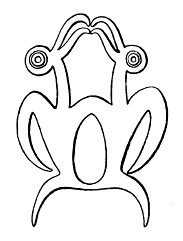 FIG. 121. — BIRD DESIGN FROM HEAD OF WOODEN IMAGE. (Brit. Mus.) 1 Our
impressions on this head are confirmed by a remark of Brother Eyraud.
“Though I
have lived in the greatest of intimacy and familiarity with them, I
have never
been able to discover them in any act of actual religious worship." — Annals of the Propagation of the Faith,
Jan. 1866. 2 The
outermost of the three hillocks on the eastern volcano on which the
Spaniards
set up the crosses in 1770. Half of it has been worn away by coastal
erosion
(fig. 78). 3 The same
word aku-aku was used for the spirit both of the living and the dead,
or else
the Tahitian "varua"; they were said to be equivalent. 4 Evidence
on this head was rather contradictory, but no Miru could be found, male
or
female, to whom the title was not given. 5
"L'lle de Paques," M. Tepano Jaussen, Bulletin Geographique,
1893, p. 241. 6 Revue
Maritime et Colonial, vol.
xxxv, p. 109. 7 Thirty
is, however, a very favourite number: cf. the folk-tales. 8
Sometimes called koho-rongo-rongo. 9 Sophora
Toromiro. 10 An
accurate large scale plan of the village was made by Lieutenant D. R.
Ritchie,
R.N., and every house was measured and described by the Expedition. 11
Recollection is naturally clearer of the removal of the statue now at
Washington, and particularly of the excellent food given to the natives
who
assisted. The figure is reported to have been taken from Ahu Apépé, an
inland
terrace not far from Rano Raraku, and been dragged down to the ship as
she lay
in La Pérouse Bay. 12 Sooty
Tern. 13 The men
of the ascendant clan are also often spoken of as the Mata-toa, or
warriors,
the other clans being the Mata-kio, or servants. 14 This
statue was removed to the mainland shortly before our arrival, and we
were able
to procure it in exchange for one of the yacht blankets. It is now at
the Pitt
Rivers Museum, Oxford (fig. iii). 15 The
figures of the bird-man, also of the ao and Ko Mari, are all roughly
carved on
the back of the Orongo statue (fig. io6). They appear, like those on
the Raraku
image, to be later workmanship than the raised ring and girdle.
Permission to
inspect can be obtained in the hall ol the British Museum;
unfortunately the
light in the portico is bad. 16 Nos. 1,
2, and 3, fig. 60, form part of this series. See also fig. 74. 17 We owe
this suggestion to Captain T. A. Joyce. 18 Those
unacquainted with the manner in which the drawing of a natural object
can,
through constant repetition, lose all resemblance to it and / become
purely
conventional are referred to Evolution in
Art, by Dr. A. C. Haddon. 19 The term
"papa" is also applied to any flat, horizontal surface of fused
igneous rock. The double use seems to be explained by connecting it
with the
facts that in Hawaii, Papa is the name of the female progenitor of the
race (or
at least of a line of chiefs), while in the Marquesas and Harvey
Islands Papa
is the earth personified, the Great Mother. — See A Brief
History of the Hawaiian People, Alexander, p. 20. |
||||||||||||||||||||||||||||||||||||||||||||||||||||||||||||||||||||||||

